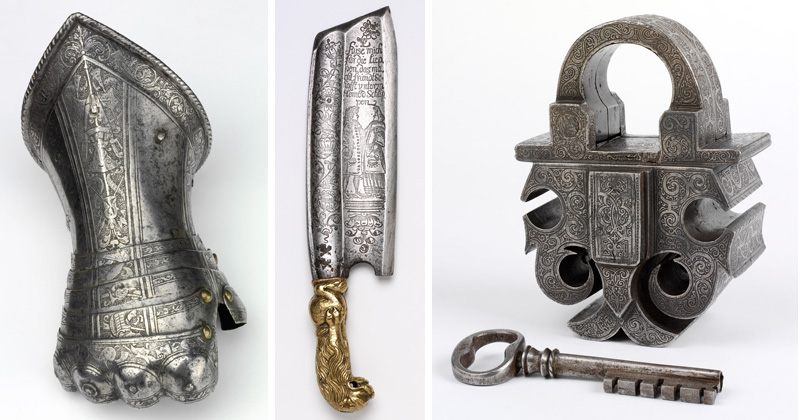Information below from the Victoria and Albert Museum, London
Etching, derived from an ancient Germanic word for ‘eat’, uses corrosive acids to bite designs into hard surfaces like metal. The background can either be eaten away so the design stands out in relief, or the design itself can be bitten into the surface. The technique creates a shallow relief making it possible to create highly decorated objects without compromising the structural integrity of the metal making it suitable for items like weapons, locks and tool. Between 1500 and 1750 production centred on southern Germany and northern Italy where etched armour was a speciality. [source]
Acids can dissolve metal by chemical reaction. This process, known as acid-etching, can be used to etch designs into metal surfaces instead of the more labour-intensive and technically demanding method of engraving by hand. The metal to be etched is first cleaned thoroughly and then coated with an acid-resistant substance such as beeswax. This is called a ‘resist’. The design is engraved in the wax to expose the metal underneath. [source]
The prepared metal is immersed in a solution of hydrochloric or nitric acid and water until its exposed areas have been eaten away to the desired depth. The resist is then removed to reveal the etching. Gilding or blackening can be added to accentuate the design. Designs on etched metalwork are often freer and less exact than in traditional engraving. They capture the ‘hand’ of the etcher rather like a pencil sketch. [source]
At the Victoria and Albert Museum in London you will find a wonderful collection of acid-etched metal art on display. You can also find more examples on their website where the images below were originally posted.
[Victoria and Albert Museum via innuendoPL]
1. Padlock and Key, c 1580
Southern Germany, Steel
To become a master locksmith an apprentice had to produce a ‘masterpiece’. Here the locksmith demonstrated his skill by creating a robust and secure lock and refining its appearance with delicate etching. Similar patterns decorated other 16th century goods and furnishings, from embroidery to tooled leather. Designs circulated among craftspeople through printed versions on paper and were widely recommended in pattern books. [source]
2. Gauntlet, c 1580
Northern Italy, Steel
This gauntlet survives from a spectacular armour. The bands of etching imitate the embroidered collars and hems of contemporary clothing. The design etched on the wrist guard shows a helmet, armour, scimitars and trumpets attached to a long central pole with sprouting leaves at the top. These military motifs derive from ancient Roman monuments depicting the practice of hanging the weapons and armour of defeated enemies from a tree. [source]
3. Casket, c 1570-1600
Germany, Steel
Strong boxes like this kept important documents and valuable jewellery safe and secure. This one is etched with allegorical figures. On the front of the casket a woman in classical costume symbolises ‘Music’. She is identified by her instruments – a lyre and a horn. Music was one of the seven liberal arts, a classical programme of education taught in universities. [source]
4. Helmet (Morion), c 1580
Northern Italy, Steel
Armour from the late 16th century was sometimes flamboyantly decorated with etching and iridescent blue and gold surfaces. Traces of gold remain in the background of the etched bands on this morion – an open helmet with a brim used by infantry soldiers. Blue colours may have been added – produced by heating the metal – but are no longer visible. [source]
5. Cranequin, c 1565-1574
Southern Germany, Steel-wood-rope
This is a device for drawing back the string of a crossbow under very high tension. In this example, the ratchet is etched in relief with dogs chasing hares and the drum in intaglio with dancing couples. This combination of scenes reflects the fact that hunting, as an elite sport, was frequently used as a metaphor to describe the pursuit of the opposite sex. [source]
6. Thigh Defence (Cuisse), c 1515-1525
Augsburg, Southern Germany – Steel
This piece of battle armour is characteristic of the early 16th century. Its fluted ridges imitate the pleated clothing fashionable at the time. The etched decoration, featuring bare-breasted sphinxes and cherubs’ heads, is very similar to surviving prints by Daniel Hopfer. Unlike the fluting, which is hammered out from behind, the etching does not alter the shape of the armour or compromise its rigidity. [source]
7. Barrel-Maker’s Knife, 1702
Germany – Steel, brass
Blades are the earliest types of objects known to have been etched with acid. This knife was used by a cooper, or barrel-maker. The etched writing on the blade has been worn away by repeated sharpening. What remains indicates that the inscription on one side is a bawdy rhyme and, on the other, a joke about the social importance of the barrel-maker. [source]
If you enjoyed this post, the Sifter
highly recommends:
